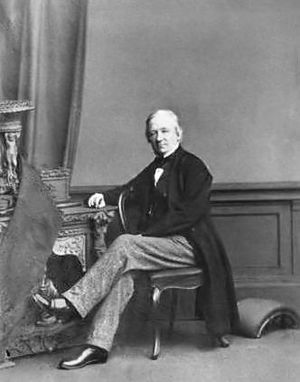Robert Hunt (scientist) facts for kids
Robert Hunt (born September 6, 1807 – died October 17, 1887) was a British expert in minerals. He was also interested in old things, wrote poetry, and was one of the first people to explore photography. Robert Hunt was born in Devonport, Plymouth, and passed away in London.
Contents
Robert Hunt's Life and Work
Early Years and Interests
Robert Hunt's father, who was a naval officer, sadly drowned when Robert was young. Robert started studying medicine in London, but he became unwell and had to move back to Cornwall. In 1829, he published a poem called The Mount’s Bay, but it did not become very popular or make much money.
In 1840, Robert Hunt became a secretary for the Royal Cornwall Polytechnic Society in Falmouth. There, he met Robert Were Fox. Together, they worked on some interesting science experiments involving physics and chemistry.
His Career in Science
Robert Hunt became a Professor of Mechanical Science at the Government School of Mines. This meant he taught about how machines work.
In 1845, Sir Henry de la Beche asked him to become the keeper of mining records at the Museum of Economic Geology. This museum later became known as the Museum of Practical Geology. When the school of mines started in 1851, Robert Hunt taught about mechanical science for two years. He also taught about experimental physics for a short time.
He joined the Royal Statistical Society in 1855. In 1858, he helped start The Miners Association with the Royal Cornwall Polytechnic Society.
One of his most important jobs was collecting and organizing the Mineral Statistics of the United Kingdom. This was a huge record of all the minerals found and used in Britain. He continued this work until he retired in 1883. After he retired, the mining record office moved to the Home Office.
Robert Hunt was chosen as a fellow of the Royal Society in 1852. This is a very important group for scientists. In 1884, he wrote a big book called British Mining. This book covered the history of mining and how it was done. He also helped edit later versions of Andrew Ure's Dictionary of Arts, Mines and Manufactures.
Other Passions and Hobbies
Robert Hunt had many interests beyond just minerals. He wrote several popular books on different topics. He was one of the first people to explore photography, he wrote poetry, and he loved learning about old stories and traditions, known as folklore.
After Daguerre invented the daguerreotype (an early type of photograph) in 1839, Hunt became very excited about photography. Just two years later, in 1841, he published his Manual of Photography. This was the first book about photography written in English! Hunt also did many experiments to understand how light works. He published a book called Researches on Light in 1844. He also invented a device called the actinograph in 1845, which helped measure the strength of light.
Hunt also loved poetry throughout his life. He regularly wrote and published poems. In the 1830s, he even tried to become a playwright, writing plays for the theater. In 1848, Hunt published a very ambitious book called The Poetry of Science. This book explained many important scientific discoveries made up to that time. It also showed how science could be beautiful and inspiring, like poetry. Hunt wanted people to see that science was a topic worthy of poetic language.
He also collected and wrote Popular Romances of the West of England (1865). This book included many old myths and legends from Cornwall. It was so popular that it was printed many times.
His Death and What He Left Behind
Robert Hunt passed away in London on October 17, 1887. A museum for minerals was created in his memory at the Redruth Mining School. However, this museum closed in 1950. The minerals from the museum were then moved to the School of Metalliferous Mining, which is now called the Camborne School of Mines.


